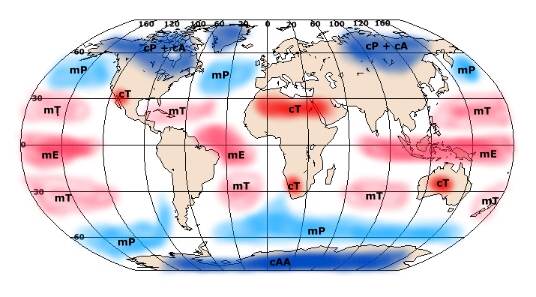6.2: Air Masses
- Page ID
- 21699
\( \newcommand{\vecs}[1]{\overset { \scriptstyle \rightharpoonup} {\mathbf{#1}} } \)
\( \newcommand{\vecd}[1]{\overset{-\!-\!\rightharpoonup}{\vphantom{a}\smash {#1}}} \)
\( \newcommand{\id}{\mathrm{id}}\) \( \newcommand{\Span}{\mathrm{span}}\)
( \newcommand{\kernel}{\mathrm{null}\,}\) \( \newcommand{\range}{\mathrm{range}\,}\)
\( \newcommand{\RealPart}{\mathrm{Re}}\) \( \newcommand{\ImaginaryPart}{\mathrm{Im}}\)
\( \newcommand{\Argument}{\mathrm{Arg}}\) \( \newcommand{\norm}[1]{\| #1 \|}\)
\( \newcommand{\inner}[2]{\langle #1, #2 \rangle}\)
\( \newcommand{\Span}{\mathrm{span}}\)
\( \newcommand{\id}{\mathrm{id}}\)
\( \newcommand{\Span}{\mathrm{span}}\)
\( \newcommand{\kernel}{\mathrm{null}\,}\)
\( \newcommand{\range}{\mathrm{range}\,}\)
\( \newcommand{\RealPart}{\mathrm{Re}}\)
\( \newcommand{\ImaginaryPart}{\mathrm{Im}}\)
\( \newcommand{\Argument}{\mathrm{Arg}}\)
\( \newcommand{\norm}[1]{\| #1 \|}\)
\( \newcommand{\inner}[2]{\langle #1, #2 \rangle}\)
\( \newcommand{\Span}{\mathrm{span}}\) \( \newcommand{\AA}{\unicode[.8,0]{x212B}}\)
\( \newcommand{\vectorA}[1]{\vec{#1}} % arrow\)
\( \newcommand{\vectorAt}[1]{\vec{\text{#1}}} % arrow\)
\( \newcommand{\vectorB}[1]{\overset { \scriptstyle \rightharpoonup} {\mathbf{#1}} } \)
\( \newcommand{\vectorC}[1]{\textbf{#1}} \)
\( \newcommand{\vectorD}[1]{\overrightarrow{#1}} \)
\( \newcommand{\vectorDt}[1]{\overrightarrow{\text{#1}}} \)
\( \newcommand{\vectE}[1]{\overset{-\!-\!\rightharpoonup}{\vphantom{a}\smash{\mathbf {#1}}}} \)
\( \newcommand{\vecs}[1]{\overset { \scriptstyle \rightharpoonup} {\mathbf{#1}} } \)
\( \newcommand{\vecd}[1]{\overset{-\!-\!\rightharpoonup}{\vphantom{a}\smash {#1}}} \)
Air mass source regions
An air mass is a vast pool of air having similar temperature and moisture characteristics. An air mass occupies thousands of square miles of the Earth's surface. Air masses are born in a source region where they take on their characteristic temperature and moisture content. Areas dominated by high pressure serve as good source regions where subsidence pushes the air toward the surface. High pressure also enables the air to move outward from the source region.
Air mass classification
Atmospheric scientists have created temperature and humidity criteria to classify each air mass, we’ll classify them based on their general conditions, e.g. warm and wet, cold and dry. The latitude of the source region fundamentally determines the temperature of an air mass. Arctic air masses form between 60o and 90o north latitude. Arctic air masses are characterized as being extremely cold air masses. Polar air masses form between 40o and 60o north or south latitude and are cold air masses but warmer than the higher latitude arctic air mass. Warm tropical air masses are found between 15o and 35o north and south latitude. The exceedingly warm equatorial air masses form near the equator. The type of surface over which air masses form also determines their humidity characteristics. Maritime (oceanic) air masses are typically moist, whereas those forming over the continents are usually dry. However, humidity is also determined by temperature so cooler maritime polar air masses are drier than warm maritime tropical air masses.
Air mass types
Figure \(\PageIndex{1}\) shows the location of the air mass source regions that affect Earth's climate. Continental arctic air (cA) is typically described as extremely cold and dry. Record setting temperatures in the middle and high latitudes are due to the invasion of this very cold mass of air. At about the same latitude in the Southern Hemisphere is found the continental Antarctic (cAA) air mass. This too is an exceedingly cold air mass and is drier than its arctic counterpart as the source region is the continent of Antarctica. Continental polar (cP) air is considered a cold and dry air mass that is warmer than the arctic air mass located to the north. Continental polar air is typically a stable or conditionally stable mass of air. Maritime polar (mP) air is cool and moist air that brings mild weather to coastal locations. Maritime polar air is warmer than continental polar air in the winter as the surface temperature of the ocean is higher. Similarly, mP air masses are typically cooler than cP air masses during the summer as the continents warm more than the ocean at these latitudes. Maritime polar air masses that enter the west coast are forced to rise up coastal mountain chains causing significant orographic uplift and precipitation. In Europe, mP air masses penetrate further inland due to the east–west orientation of the mountains. Thus smaller temperature ranges and higher humidity typical of maritime climate are found further inland in Europe than in North America.

Maritime tropical (mT) air masses are warm and moist air masses that are responsible for much of the precipitation east of the Rocky mountains in the United States. Precipitation occurs when mT air collides with cP air causing the warmer and less dense mT air to rise, cool, and condense into clouds. Over subtropical and tropical continents the source region for the hot and dry continental tropical (cT) air mass is found. Major source regions are the great deserts of the Earth such as the Sahara, Arabian, and Australian. The extremely low humidity is due to the lack of available water for evaporation as well as the subsidence of the subtropical high. The southwest desert of the United States serves as a source region for cT air too, but only during the summer. Surface temperatures in the winter are too cold to create a continental tropical air mass there. Near the equator the exceedingly warm and humid maritime equatorial air masses form. Convection and convergence of this air mass in the Intertropical Convergence Zone is one for the reasons for the heavy rainfall experienced in the rain forests of this region.

